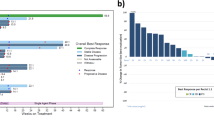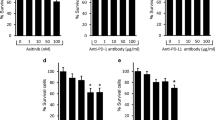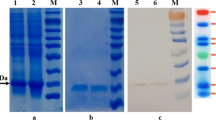Abstract
The clinical and immune modulatory effects of interleukin-2 (IL-2) and interferon (INF) alfa-2a were examined in a phase II study in patients with metastatic renal cell carcinoma (six patients) and melanoma (eight patients). Treatment consisted in IL-2 3 MU/m2 continuous infusion days 1-4 and INF alfa-2a 6 MU/m2 subcutaneously day 1 and 4, both given on alternate weeks. Tumour response was assessed after four cycles of treatment or earlier, if necessary. Patients with stable disease or response were to be continued for another nine cycles or up to disease progression. The 14 patients received a total of 60 cycles of treatment. Major toxicities (WHO Grade III/IV) were fever, capillary leak syndrome with hypotension, nausea and vomiting, erythema with pruritus, leuco- and thrombopenia and sepsis with staphylococcus aureus. Five of 14 patients (36%) developed a self limiting autoimmune thyroiditis with HLA-DR expression on thyrocytes. Long term treatment toxicity was moderate with an average weight loss of 5% and an average fall in Karnofsky index of 10% compared to baseline. No responses were seen in renal cell carcinoma, two patients with melanoma had a partial and two a minor response with a duration of 1-7 months. Serial measurements of immune modulatory parameters showed a functional response to treatment with an increase of NK- and LAK-activity during the first two cycles, followed by a plateau and decrease during the third and fourth cycles. These findings were paralleled by a successive decline in treatment induced INF gamma response. These findings suggest, that alternative weekly treatment with IL-2 and INF alfa-2a results in an exhaustion of lytic capacity of NK- and LAK-cells and an attenuation of secondary cytokine release.
This is a preview of subscription content, access via your institution
Access options
Subscribe to this journal
Receive 24 print issues and online access
$259.00 per year
only $10.79 per issue
Buy this article
- Purchase on Springer Link
- Instant access to full article PDF
Prices may be subject to local taxes which are calculated during checkout
Similar content being viewed by others
Author information
Authors and Affiliations
Rights and permissions
About this article
Cite this article
Pichert, G., Jost, L., Fierz, W. et al. Clinical and immune modulatory effects of alternative weekly interleukin-2 and interferon alfa-2a in patients with advanced renal cell carcinoma and melanoma. Br J Cancer 63, 287–292 (1991). https://doi.org/10.1038/bjc.1991.67
Issue Date:
DOI: https://doi.org/10.1038/bjc.1991.67
This article is cited by
-
The Society for Immunotherapy of Cancer consensus statement on tumour immunotherapy for the treatment of cutaneous melanoma
Nature Reviews Clinical Oncology (2013)
-
Relationship between soluble tumor necrosis factor (TNF) receptors and TNF? during immunotherapy with interleukin-2 and/or interferon ?
Cancer Immunology Immunotherapy (1994)



